created 2025-04-08, & modified, =this.modified
Why I’m reading
I want to know more about that period where reading did not exist, or reading was in early stages.
I have questions about text.
I read a lot.
Reading means approaching something is just coming into being. Italo Calvino
Reading Shadows
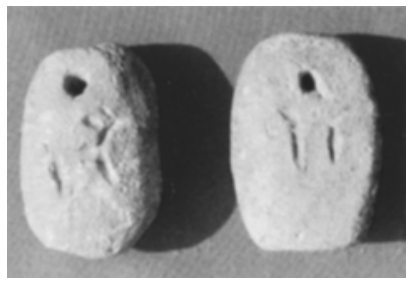
There is something intensely moving in these tablets. Perhaps, when we stare at these pieces of clay carried by a river which no longer exists, observing the delicate incisions portraying animals turned to dust thousands and thousands of years ago, a voice is conjured up, a thought, a message that tells us, “Here were ten goats,” “Here were ten sheep,” something spoken by a careful farmer in the days when the deserts were green. By the mere fact of looking at these tablets we have prolonged a memory from the beginnings of our time, preserved a thought long after the thinker has stopped thinking, and made ourselves participants in an act of creation that remains open for as long as the incised images are seen, deciphered, read.
The eye
Empedocles - the eye was born from the goddess Aphrodite, who “confined a fire in the membranes and delicate cloths; these held back the deep water flowing around, and let through the inner flames to the outside.”
Epicurus - thin films of atoms that flowed from the surface of every object and entered our eyes and minds in a constant and ascending rain, drenching us all in the qualities of the object.
Euclid - the contrary to Epicurus, where the rays are sent out of the observers eyes to apprehend the object observed.
Roger Bacon - when we look at an object (a tree or the letters SUN) a visual pyramid is formed that has its base on the object itself and its apex at the center of the curvature of the cornea. We “see” when the pyramid enters our eyes and its rays are arranged on the surface of our eyeball, refracted in such a way that they do not intersect. It’s an active process where the object enters the eye and is grasped by the eyes “visual powers.”
Neurolinguistics
1865 - French scientists Michel Dax and Paul Broca suggested that the vast majority of humankind, as result of a genetic process which begins at conception, is born with a left cerebral hemisphere that will eventually become to dominant part of the brain for encoding and decoding language; a much smaller proportion, mostly left-handers or ambidextrous people, develop this function in the right cerebral hemisphere. In cases of early damage, there is reprogramming which leads to development of the right hemisphere. But neither will act until the person is actually exposed to language.
We “discover” a word because the object or idea it represents is already in our mind, “ready to be linked up with the word”.
The words spoken (and words read) belong neither to use nor our parents, to our authors; they occupy a space of shared meaning, a communal threshold which lies at the beginning of our relationship to the arts of conversation and reading.
The possible disconnections seem endless.
Neither is the primary act of scanning a page with our eyes a continuous systematic process. It is usually assumed that when we are reading our eye smoothly travels without interruptions along the lines of the page, and that when we are reading Western writing, our eyes go left to right. This isn’t so. A century ago, the French ophthalmologist Émile Javal discovered that our eyes actually jump about the page; these jumps or saccades take place three or four times per second, at a speed of about 200 degrees per second. The speed of the eye’s motion across the page — but not the motion itself — interferes with perception, and it is only during the brief pause between movements that we actually “read”. Why our sense of reading is related to the continuity of the text on the page or to the scrolling of the text on the screen, assimilating entire sentences or thoughts, and not to the actual saccadic movement of the eyes, is a question which scientists have not yet been able to answer.
The Silent Readers
If reading out loud was the norm from the beginnings of the written word, what was it like to read in the great ancient libraries?
Further thoughts
In searching more for this unique fact, I find it’s a controversial, if not debunked, point that reading aloud was the norm.
Greek literature, at least up to Thucydides, was intended for public delivery or performance, and from the early part of the fourth century B.C. on to the end of antiquity, rhetoric was the foundation and eloquence the aim of the educational process.
The less extreme view is that reading aloud was unusual enough to surprise.
But these have been refuted, as silent reading was about three times as common as references towards aloud reading.
…For judging a thing and discovering its nature, the internal logos in this context, (‘faculty of reasoning’) of thought is sufficient: uttered logos makes no contribution here — rather, its activity, like the exercise of our senses, disturbs and distracts one’s investigations. That is why it tends to be in states of peace and quiet that we discover the objects of our inquiry, and why we keep quiet when engaged in the readings themselves if we are concentrating hard on the texts before us. What talk is useful for, by contrast, is passing on the results of our inquiries to other people.
The Book of Memory
Reading either in silence or aloud, this man was able to impress the text (in Cicero’s phrase, which Augustine liked to quote) “on the wax tablets of memory”, to be recalled and recited at will in whatever order he chose, as if he were flipping through the pages of a book. By recalling a text, by bringing to mind a book once held in the hands, such a reader can become the book, from which he and others can read.
The god of Thoth in Egypt, inventor of dice, checkers, numbers, geometry, astronomy and writing, visited the King of Egypt and offered him these inventions to pass onto his people. The king discussed the merits of each, coming to writing Thoth said “ Here, is a branch of learning that can improve their memories; my discovery provides a recipe for both memory and wisdom.” But the king thought it would implant forgetfulness in their souls and they’d cease to exercise memory, relying on what was written, calling things no longer from themselves. What you have discovered is a recipe for reminder, not memory. As men are not filled with wisdom but conceit of wisdom, they will be a burden to their fellow men.
Socrates: “must be singularly simple-minded to believe that written words can do anything more than remind one of what one already knows.”
The text, like a painted picture, said only “the moon of Athens”; it was the reader who furnished it with a full ivory face, a deep dark sky, a landscape of ancient ruins along which Socrates once walked.
In De viris illustribus Petrach remarks a book was to serve the reader as a sort of artificial memory of rare and dispersed text. It is not only collected but the reader then lent them an order and a memory.
Learning to Read
Latin
In 1521, Martin Luther began publication of his German Bible; in 1526, William Tyndale brought out his English translation of the Bible in Cologne and Worms, having been forced to leave England under threat of death; in 1530, in both Sweden and Denmark, a government decree prescribed that the Bible was to be read in church in the vernacular. In Rhenanus’s days, however, the prestige and official use of Latin continued not only in the Catholic Church, where priests were required to conduct services in Latin, but also in universities such as the Sorbonne, which Rhenanus wished to attend. Latin schools were therefore still in great demand
Bacchari - to go, run or roam about in a wild, raving, raging or furious manner.
For ancient students:
- First, literra or the literal sense of the text.
- Through this the student acquired, sensus or the meaning of the text according to different established interpretations.
- Finally, the exegesis – the sententia which the opinions of the approved commentators are discussed.
Isidore of Seville, 7th century theologian whose Etymologies, a vast work of 20 volumes explained and discussed the meaning and uses of words. Hofman instructed students to compile Index rerum et verborum (Index of Things and Words) listing the subjects they studied.
The Missing First Page
However many pages the studious man reads, he must never forget that she has not yet reached the very first page.
Dante - a text has at least two readings, “for we obtain one meaning from the letter of it, and another from that which the letter signifies - the first is called literal, but the other allegorical or mystical.”
Provided the reader and the text share a common language, any reader can make some sense out of any text.
Kafka: Throughout his life, Kafka read with the feeling that he lacked the experience and knowledge necessary to achieve even the beginning of an understanding.
Kafka:quote
One reads in order to ask questions.
also:
I think we ought to read only books that bite and sting us. If the book we are reading doesn’t shake us awake like a blow on the skull, why bother reading it in the first place? So that it can make us happy, as you put it? Good God, we’d be just as happy if we had no books at all; books that make us happy we could, in a pinch, also write ourselves. What we need are books that hit us like a most painful misfortune, like the death of someone we loved more than we love ourselves, that make us feel as though we had been banished to the woods, far from any human presence, like a suicide. A book must be the axe for the frozen sea within us. That is what I believe.
Picture Reading
Codex Seraphinianus - Luigi Serafini had created an encyclopedia of an imaginary world, in a nonsensical alphabet Serafini had invented during two long years in a small apartment in Rome.
Birth of Biblical Iconography
Precursor: Saint Nilus of Ancyra, now Ankara of Turkey. He suggested painting scenes of the Old and New Testament, painted by the hands of a gifted artist. These would serve as books for the unlearned, and press upon them record of God’s mercies.
Images of a cantor, Haggadah reading by a desk, his faced replaced by that of a bird to satisfy the Old Testament’s injunction against representing the human figure.
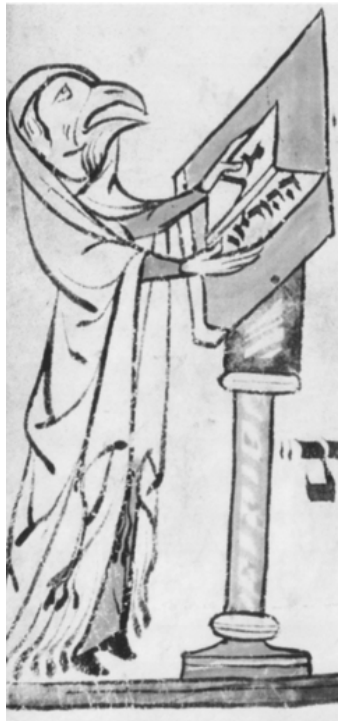 By the time of Saint Nilus’s recommendation, the iconography of the Christian Church was already developing conventional pictures of the Spirit’s ubiquity.
By the time of Saint Nilus’s recommendation, the iconography of the Christian Church was already developing conventional pictures of the Spirit’s ubiquity.
In the 14th century images of Nilas were reduced and collected to the shape of a book
The books they created were made almost entirely out of juxtaposed scenes, with just a few words, sometimes as captions on the sides of the page and sometimes issuing from the mouths of characters in banner-like cartouches, like the balloons in today’s comic strips.
Chained to a lectern, opened to an appropriate page, the Biblia Pauperum would display its double images to the faithful sequentially, day after day, month after month. Many would not be able to read the words in Gothic script surrounding the depicted personages; few would grasp the several meanings of each image in their historical, moral and allegorical significance. But the majority of the people would recognize most of the characters and scenes, and be able to “read” in those images a relationship between the stories of the Old Testament and the stories of the New, simply because of their juxtaposition on the page.
Being Read To
The practice of public reading in Cuba, where in the mid-19th century barely 15% of the working population could read. Being read to, as the cigar workers found out, allowed them to overlay the mechanical, mind-numbing activity of rolling the dark scented tobacco leaves with adventures to follow, ideas to consider, reflections to make theirs. In very little time, acquired a reputation for being subversive.
La Aurora
Reading in the shops has begun for the first time among us, and the initiative belongs to the honoured workers of El Fígaro. This constitutes a giant step in the march of progress and the general advance of the workers, since in this way they will gradually become familiar with books, the source of everlasting friendship and great entertainment.”
Soon, “It is forbidden to distract workers of the tobacco shops, workshops and shops all of kinds with the reading of books a newspapers. The police she exercise constant vigilance to enforce this decree.”
Thought
Now, the proliferation of podcasts, audiobooks and even watching films on a secondary monitor (or primary) at work.
During reading possession of the book acquires talismanic value. In north of France, story-tellers use books as props; they memorize the text, and pretend the read from the book, even holding it upside down.
Something about the possession of a book — an object that can contain infinite fables, words of wisdom, chronicles of times gone by, humorous anecdotes and divine revelation — endows the reader with the power of creating a story, and the listener with a sense of being present at the moment of creation.
The Shape of the Book
Not all Mesopotamian books were meant to be held in the hand. There exists texts written in larger surfaces, like the Middle Assyrian Code of Laws which measures 67 square feet and carries its text in columns on both sides. It was meant as a work of reference. The size of the book of law might have reinforced the authority of the laws themselves.
The codex prevailed, and by AD 400 the classical scroll had been all but abandoned, with most books being produced as gathered leaves in rectangular format.
Parchment folded once, is a folio. Folded twice, a quarto. Folded thrice, an octavo.
Paper sizes were standardized in France in 1527, with François I declaring anyone breaking the rule to be thrown in prison.
The most popular shapes books have acquired through the ages, have allowed the book to be held comfortably within the reader’s hand.
Thought
This idea of comfort of reading. I know a lot of physical book readers have had e-readers that allow them to read in bed easier (backlit, single arm use due to never having to hold your page.)
A large book will always be difficult
or the well-filled cupboards (armaria) of the booksellers.”
Thought
I’m not familiar with armaria but I am wondering if there’s a connection with Armoire (which I looked up, naively wondering if body connection.). It could be Amoire → Armbry which was a recessed cabinet or cupboard found in the church to store vessels and items.
Middle English: from Old French armarie, from Latin armarium ‘closet, chest’, from arma ‘utensils’.
The Lectern, Desk and other tools for ease of reading:
rel:Spliced Book - Alternative Reading Methods
A fourteenth- century engraving shows a scholar in a book-lined library writing at an elevated, octagonal desk-cum-lectern that allows him to work on one side, then swivel the desk and read the books laid ready for him on the seven other sides
Thought
In the 1440s Johann Gutenberg realized that speed and efficiency could be gained by using reusable type rather than woodcut blocks. Between 1450-55 he produced a bible with 42 lines to each page, the first book printed by type.
incunabula - Latin word meaning “related to the candle” used to describe books printed before 1500.
hornbook - for students; a thin board of wood, with a sheet on which were printed the alphabet, the lords prayer and sometimes numbers.
Gustave Dore satirizing the European fad for large-format books.
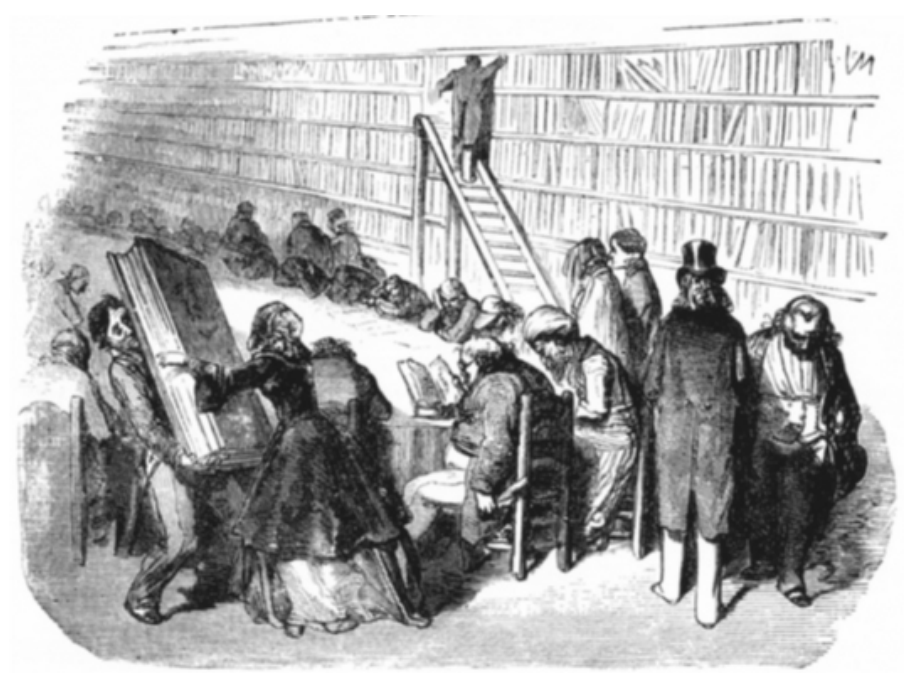 Books were now possible to travel with. “In nineteenth-century England, the newly leisured bourgeoisie and the expansion of the railway combined to create a sudden urge for long journeys, and literate travellers found that they required reading material of specific content and size.”
Books were now possible to travel with. “In nineteenth-century England, the newly leisured bourgeoisie and the expansion of the railway combined to create a sudden urge for long journeys, and literate travellers found that they required reading material of specific content and size.”
15th century heart shaped book
Very few odd shapes of book survive. Heart shaped books containing illuminated love lyrics.
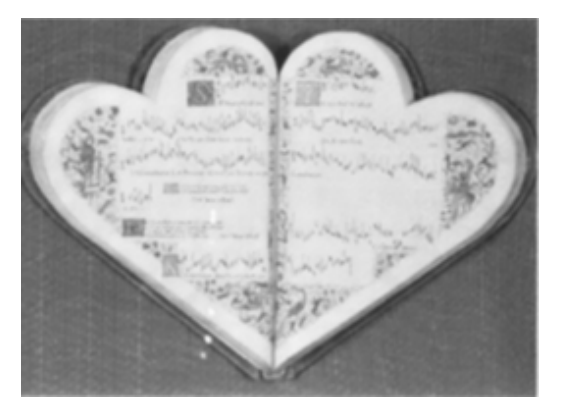
The 17th century Enclosed Flower-Garden, the tiniest book.
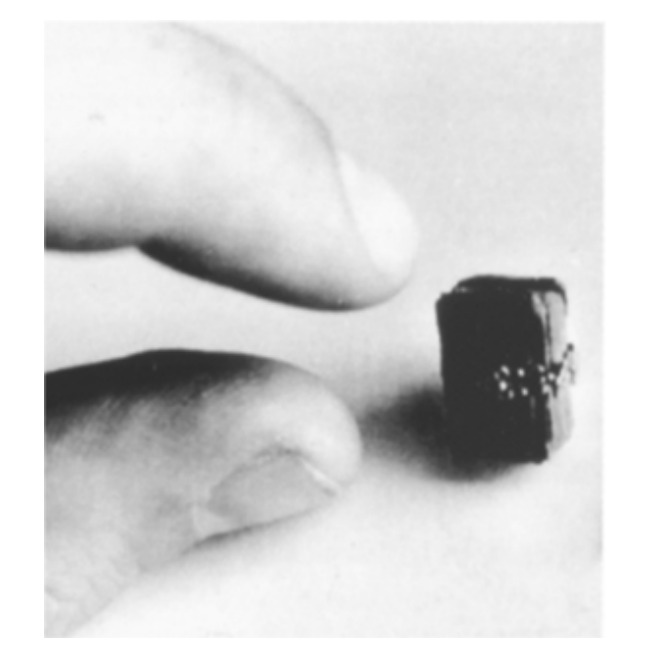
Private Reading
“I seldom read on beaches or in gardens,” confessed Marguerite Duras. “You can’t read by two lights at once, the light of day and the light of the book. You should read by electric light, the room in shadow, and only the page lit up.
cubiculum - a private room in the ancient Roman house. It was used for the functions of a modern bedroom, sleep and sex. It was used for quiet, secret meetings and could have been used as a library.
Metaphors of Reading
rel: Metaphors We Live By by Lakoff & Johnson
1774, Goethe
See how Nature is a living book, *Misunderstood but not beyond understanding. Now, in 1892, days before his death, Whitman agreed: In every object, mountain, tree, and star — in every birth and life, As part of each — evolv’d from each — meaning, behind the ostent, A mystic cipher waits infolded.
Reading and gastronomic metaphor became common rhetoric
“I walke manie times into the pleasant fieldes of the Holye Scriptures, where I pluck up the goodlie greene herbes of sentences, eate them by reading, chewe them up musing, and laie them up at length in the seate of memorie … so I may the lesse perceive the bitterness of this miserable life.”
The ravenous reader.
Power of the Reader
4the millennium BC In all probability, writing was invented for commercial reasons, to remember that a certain number of cattle belonged to a certain family, or were being transported to a certain place. A written sign served as a mnemonic device: a picture of an ox stood for an ox, to remind the reader that the transaction was in oxen, how many oxen, and perhaps the names of a buyer and seller. Memory, in this form, is also a document, the record of such a transaction.
Thought
But were the reader and the writer created simultaneously? For me, I’m attracted to the opposite idea – that the reader came first.
It’s hard to exaggerate the importance of the Mesopotamian scribe. He was the hand and eye and voice through which communications were established and messages deciphered.
The scribe copyist as reader-writer.
Richard Wilbur, on the tragedy that befalls civilization when it loses its readers.
TO THE ETRUSCAN POETS
Dream fluently, still borthers, who when young
Took with your mothers' milk the mother tongue,
In which pure matrix, joining world and mind,
You strove to learn some line of verse behind
Like a fresh track across a field of snow,
Not reckoning that all could melt and go.
Alexandria
Those who can read see twice as well - Menander in 4BC
Before the invention of printing, the papal library of Avignon was the only one in the Christian West to exceed two thousand volumes.
In Alexandria, “every niche or recess must have been dedicated to a class of authors each marked with appropriate heading.” The space was expanded until the library was said to house nearly half a million scrolls, plus 40K more stored in an attached building.
The memory of the world.
Accumulation of knowledge, isn’t knowledge. Decimus Magnus Ausonius:
You’ve bought books and filled shelves, O Lover of the Muses. Does that mean you’re a scholar now? If you buy string instruments, plectrum and lyre today: Do you think that by tomorrow the realm of music will be yours?
Callimachus of Cyrene on how to solve discovery problem, within a large disorganized collection of works
- he believed literature should be concise and unadorned (epics were garrulous and obsolete.)
- He began cataloging in a system based not on orderly listing of library possessions but on a preconceived formulation of the world itself.
- He divided the library in shelves or tables (pinakoi) arranged in eight classes: drama, oratory, lyric poetry, legislation, medicine, history, philosophy and miscellany.
The association of books with their readers is unlike any other between objects and their users. Tools, furniture, clothes — all have a symbolic function, but books inflict upon their readers a symbolism far more complex than that of a simple utensil.
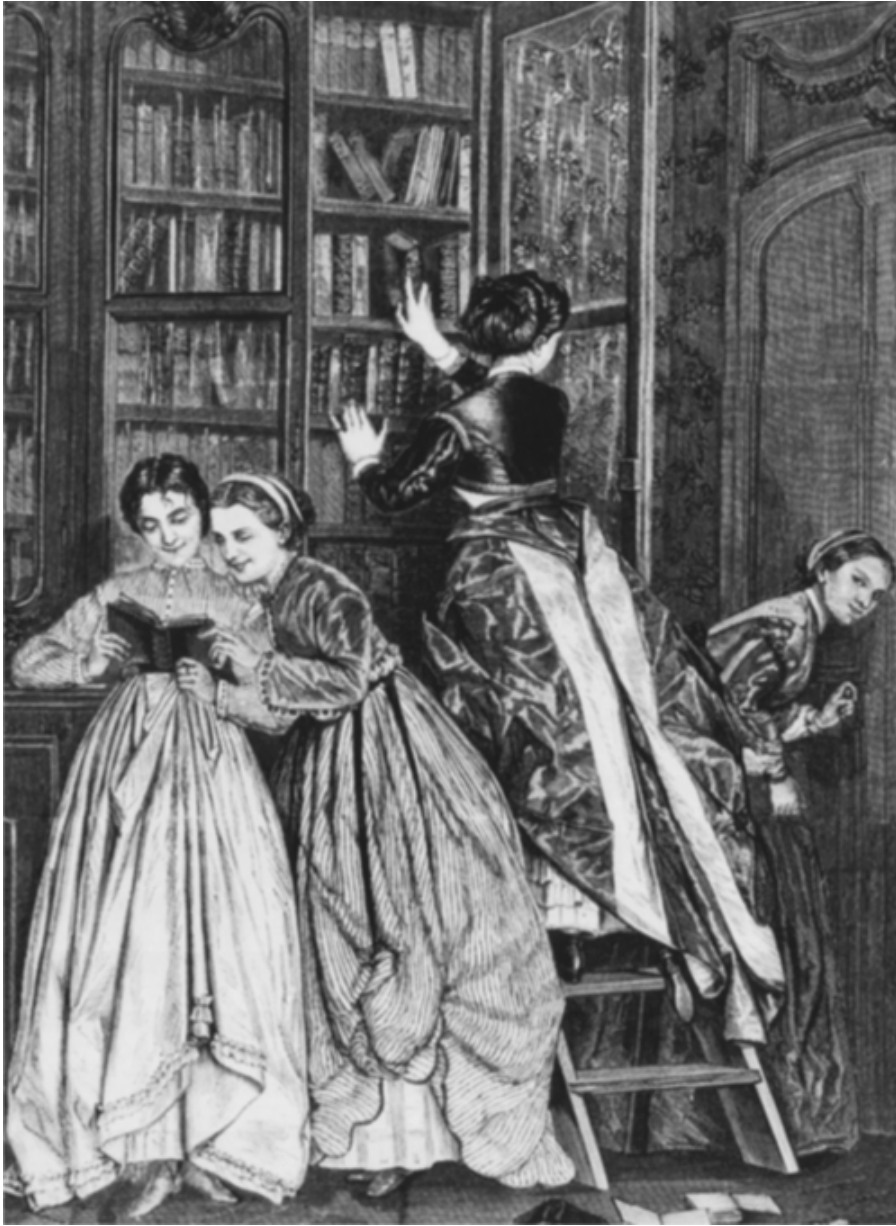 In Japanese Court the women’s days were spent mostly “gazing into space” - suffering from leisure, akin to European melancholy. They created their own literature kabanabungaku - women’s writing, restricted to a woman’s hands.
In Japanese Court the women’s days were spent mostly “gazing into space” - suffering from leisure, akin to European melancholy. They created their own literature kabanabungaku - women’s writing, restricted to a woman’s hands.
Pillow Book is mentioned
Letters are commonplace enough, yet what splendid things they are! When someone is in a distant province and one is worried about him, and then a letter suddenly arrives, one feels as though one were seeing him face to face. And it is a great comfort to have expressed one’s feelings in a letter — even though one knows it cannot yet have arrived.
Stealing Books
Book thieves plagued the Middle Ages and the Renaissance; in 1752 Pope Benedict XIV proclaimed a bull in which book thieves were punished with excommunication.

They are not turning their backs on the war, or ignoring the destruction. They are not choosing the books over life outside. They are trying to persist against the obvious odds; they are asserting a common right to ask; they are attempting to find once again — among the ruins, in the astonished recognition that reading sometimes grants — an understanding.
